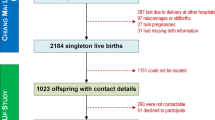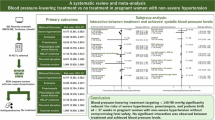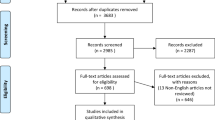Abstract
A number of studies have shown that children born by cesarean section have lower blood pressure during the neonatal period. The aim of this study was to investigate whether mode of delivery influenced childhood blood pressure: at age 7.5 to 8 y in a cohort of 756 children born preterm, at 7 to 9 y in a pilot study of 166 children born at term in the United Kingdom, and in a cohort of 650 Tasmanian children born at term. In the preterm cohort, systolic blood pressure was significantly lower in children born by cesarean section rather than delivered vaginally (99.3 ± 10.0 versus 101.4 ± 9.4 mm Hg; 95% confidence interval, −0.69 to −3.46;p = 0.003), with a significant trend to having a higher pressure in those born by breech versus forceps versus spontaneous vaginal delivery versus cesarean section. These findings were not replicated in the term cohorts. This raises the hypothesis that there is a sensitive period for programming later blood pressure by factors associated with mode of delivery and that this period does not extend to full-term.
Similar content being viewed by others
Log in or create a free account to read this content
Gain free access to this article, as well as selected content from this journal and more on nature.com
or
Abbreviations
- CI:
-
confidence interval
References
Lucas A 1994 Role of nutritional programming in determining adult morbidity. Arch Dis Child 71: 288–290.
Lucas A, Morley R, Cole TJ, Gore SM 1994 A randomised multicentre study of human milk versus formula and later development in preterm infants. Arch Dis Child Fetal Neonatal Ed 70: F141–F146.
Lucas A, Morley R, Cole TJ, Gore SM, Lucas PJ, Crowle P, Pearse R, Boon AJ, Powell R 1990 Early diet in preterm babies and developmental status at 18 months. Lancet 335: 1477–1481.
Lucas A, Morley R, Cole TJ 1998 Early diet in preterm babies and later intelligence quotient: a randomised trial. BMJ 317: 1481–1487.
Barker DJ 1996 The fetal origins of hypertension. J Hypertens Suppl 14: S117–S120.
Holland WW, Young LM 1956 Neonatal blood pressure in relation to maturity, mode of delivery, and condition at birth. BMJ: 1331–1333.
Kraus von A 1970 Blood pressure in neonates born spontaneously, by Caesarean section, vacuum extraction, breech or with maternal toxaemia. Zentralbl Gynakol 9: 276–279.
O'Sullivan IJ, Kearney PJ, Crowley MJ 1996 The influence of some perinatal variables on neonatal blood pressure. Acta Paediatr 85: 849–853.
Morley R, Lucas A 1994 Size at birth and later blood pressure. Arch Dis Child 70: 536–537.
Dwyer T, Ponsonby A-L, Newman NW, Gibbons LE 1991 Prospective cohort study of prone sleeping position and sudden infant death syndrome. Lancet 337: 1244–1247.
Nielsen PE, Clausen LR, Olsen CA, Olsen JA 1989 Blood pressure measurement in childhood and adolescence: international recommendations and normal limits of blood pressure. Scand J Clin Lab Invest Suppl 192: 7–12.
Brinton TJ, Walls ED, Yajnik AK, Chio SS 1998 Age-based differences between mercury sphygmomanometer and pulse dynamic blood pressure measurements. Blood Press Monit 3: 125–129.
El-Khodor BF, Boksa P 1997 Long-term reciprocal changes in dopamine levels in prefrontal cortex versus nucleus accumbens in rats born by Caesarean section compared to vaginal birth. Exp Neurol 145: 118–129.
El-Khodor BF, Boksa P 1998 Birth insult increases amphetamine-induced behavioral responses in the adult rat. Neuroscience 87: 893–904.
Moftaquir-Handaj A, Barbe F, Barbarino-Monnier P, Aunis D, Boutroy MJ 1995 Circulating chromogranin A and catecholamines in human fetuses at uneventful birth. Pediatr Res 37: 101–105.
Falconer AD, Lake DM 1982 Circumstances influencing umbilical cord plasma catecholamines at delivery. Brit J Obstet Gynaecol 9: 44–49.
Lagercrantz H, Bistoletti P 1977 Catecholamine release in the newborn infant at birth. Pediatr Res 11: 889–893.
Irestedt L, Lagercrantz H, Hjemdahl P, Hagnevik K, Belfrage P 1982 Fetal and maternal plasma catecholamine levels at elective caesarean section under general or epidural anesthesia versus vaginal delivery. Am J Obstet Gynecol 142: 1004–1010.
Padbury JF, Roberman B, Oddie TH, Hobel CJ, Fisher DA 1982 Fetal catecholamine release in response to labor and delivery. Obstet Gynecol 60: 607–611.
Eliot RJ, Lam R, Leake RD, Hobel CJ, Fisher DA 1980 Plasma catecholamine concentrations in infants at birth and during the first 48 hours of life. J Pediatr 96: 311–315.
Lundberg JM, Hemsen A, Fried G, Theodorsson-Norheim E, Lagercrantz H 1986 Co-release of neuropeptide Y (NPY)-like immunoreactivity and catecholamines in newborn infants. Acta Physiol Scand 126: 471–473.
Lumbers ER, Reid GC 1977 Effects of vaginal delivery and Caesarean section on plasma renin activity and angiotensin II levels in human umbilical cord blood. Biol Neonate 31: 127–134.
Bird JA, Spencer JA, Mould T, Symonds ME 1996 Endocrine and metabolic adaptation following caesarean section or vaginal delivery. Arch Dis Child Fetal Neonatal Ed 74: F132–F134.
Dodic M, May CN, Wintour EM, Coghlan JP 1998 An early prenatal exposure to excess glucocorticoid leads to hypertensive offspring in sheep. Clin Sci Colch 94: 149–155.
Nyirenda MJ, Lindsay RS, Kenyon CJ, Burchell A, Seckl JR 1998 Glucocorticoid exposure in late gestation permanently programs rat hepatic phosphoenolpyruvate carboxykinase and glucocorticoid receptor expression and causes glucose intolerance in adult offspring. J Clin Invest 101: 2174–2181.
Morley R, Leeson Payne C, Lister G, Lucas A 1995 Maternal smoking and blood pressure in 7. Arch Dis Child 72: 120–124.
Law CM, Shiell AW 1996 Is blood pressure inversely related to birth weight? The strength of evidence from a systematic review of the literature. J Hypertens 14: 935–941.
Acknowledgements
The authors thank Dr. Catherine Leeson-Payne and Dr. Gill Lister for measuring blood pressure in children from the preterm cohort in the United Kingdom, and Dr. Anne-Louise Ponsonby, who made a major contribution to the Tasmanian Infant Health Survey, as well as the nurses who measured blood pressures in Tasmania. We especially thank the children taking part in these studies, their families, and the schools who provided facilities.
Author information
Authors and Affiliations
Additional information
The preterm study was funded by Farley Health Products (a division of HJ Heinz & Co Ltd). The Tasmanian cohort study was funded by the US National Institutes of Health (grant HD28979–01A1), Tasmanian State Government, Australian Rotary Health Research Fund, National Health and Medical Research Council of Australia, Sudden Infant Death Syndrome Research Foundation, National Sudden Infant Death Syndrome Council of Australia, Community Organisations' support program of the Department of Human Services and Health, Zonta International, Wyeth Pharmaceuticals, and Tasmanian Sanatoria After-Care Association.
Rights and permissions
About this article
Cite this article
Morley, R., Kennedy, K., Lucas, A. et al. Mode of Delivery and Childhood Blood Pressure. Pediatr Res 47, 463–467 (2000). https://doi.org/10.1203/00006450-200004000-00009
Received:
Accepted:
Issue date:
DOI: https://doi.org/10.1203/00006450-200004000-00009



